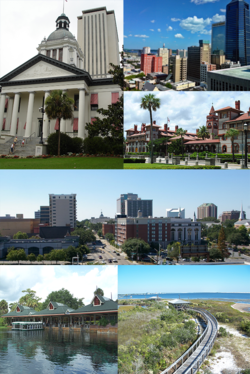North Florida
| North Florida | |
|---|---|
| Region | |

Top left to right: Florida State Capitol in Tallahassee, Downtown Jacksonville,
Flagler College, Tallahassee skyline Bottom left to right: Silver Springs Nature Theme Park, and Big Lagoon State Park |
|
 |
|
| Country |
|
| State |
|
| Largest city |
|
| Population (2010) | |
| • Total | 3,753,144 (approximate area) |
North Florida is a region of the U.S. state of Florida, comprising the northern parts of the state. It is one of Florida's three most common "directional" regions, along with Central Florida and South Florida. It includes Jacksonville and nearby localities in Northeast Florida, an interior region known as North Central Florida, and the Florida Panhandle.
As with many vernacular regions, North Florida does not have any officially designated boundaries or status, and is defined differently in different sources. A 2007 study of Florida's regions by geographers Ary Lamme and Raymond K. Oldakowski found that Floridians surveyed identified "North Florida" as comprising the northernmost areas of the state, including both the peninsula and the Florida Panhandle. Additionally, two localized "directional" regions had emerged: North East Florida, representing the area around Jacksonville on the Atlantic coast, and North Central Florida, comprising the central area. North Florida is one of Florida's three most common directional regions, along with Central Florida and South Florida. The region includes smaller vernacular regions, particularly along the coast, including the Emerald Coast and the Big Bend on the Gulf Coast and the First Coast and Halifax area on the Atlantic. Lamme and Oldakowski note that the directional region is more commonly used in the interior areas than on the coast.
...
Wikipedia
